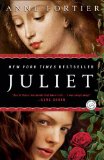 At BookBrowse we don't just review books we also explore the stories behind the books. For example, here is our "Beyond the Book" feature for Anne Fortier's "Juliet" which published in paperback a couple of weeks ago...
At BookBrowse we don't just review books we also explore the stories behind the books. For example, here is our "Beyond the Book" feature for Anne Fortier's "Juliet" which published in paperback a couple of weeks ago...
Search the web for "famous love stories" and you'll find that most sites rank Shakespeare's Romeo and Juliet in 1st place. Considering how few of the general populous have actually read or watched a performance of Shakespeare's arguably most famous play in recent years it seems likely that what keeps this pair of star-crossed lovers in everyone's minds is not Shakespeare's work itself but the countless adaptations, parodies and representations of it since it was first performed in the late 16th century. In fact, it's difficult to think of a single literary work that has inspired more artistic endeavors. Tchaikovsky's overture, Prokofiev's ballet and West Side Story are just the tip of the iceberg - various sources estimate there are upwards of 77 films and 24 operas based on Shakepeare's Romeo and Juliet, plus any number of musical pieces, paintings and books.
But what inspired Shakespeare to pen the story that has subsequently inspired 500 years of artistic endeavors?
The true origin is likely lost in the mists of time, but for our purposes let's start with the Roman myth, as told by Ovid, of the doomed Babylonian lovers Pyramus and Thisbe. Forbidden to marry by their parents they arrange to meet under a mulberry tree. Thisbe arrives first but, seeing a lioness with a kill, flees leaving her veil behind her, which the lioness mutilates. Pyramus arrives and, on seeing the bloody veil, falls on his sword splashing the white mulberries with his blood. Thisbe returns, sees her lover dead and stabs herself with a sword - and in honor of the young lovers the gods turn the mulberry fruit red.
Fast forward to Dante's Divine Comedy (1308-1321) and we find a reference to the warring families of Montecchi and Cappalletti, who were political rivals in Lombardy.
About a century and a half later Mauccio Salernitano (1410–1475) writes a story of doomed lovers set in Siena, Tuscany (which is also the setting of Anne Fortier's Juliet.).
In 1530, Luigi da Porto adapts Salernitano's story, moving the location to Verona, and naming his lovers Giuletta Capuleti and Romeo Montecchiand.
Fifteen years later Matteo Bandello publishes his version of da Porto's novel as a poem. Shortly after Pierre Boaistuau translates the story into French, adding a good dose of moralizing and rhetorical outbursts.
Then, in 1562, Arthur Brooke translates Boaistuau's version into English, adding a few flourishes of his own and naming it The Tragicall History of Romeus and Juliet.
It is Brooke's poem that is believed to be the basis for Shakespeare's Romeo and Juliet (~1954), with additional details provided by a version of the story from William Painter's Palace of Pleasure (1566) - a collection of sixty stories which provided Shakespeare with inspiration not just for Romeo and Juliet but also for other plays including Timon of Athens and All's Well That Ends Well.
And thus, perhaps, we have the answer to why Shakespeare's Romeo and Juliet has such lasting appeal. It's not really Shakespeare's play, or its many reworkings, that holds us in thrall, but the simple timeless tragedy of star-crossed lovers, whether their story be set in ancient Mesopotamia, medieval Italy, or in the modern day, such as in Anne Fortier's Juliet.
Browse an excerpt, reviews and discussion guide from "Juliet", and an interview with Anne Fortier.
BookBrowse's reviews and backstories are two of the many benefits available to members for $29.95/year.